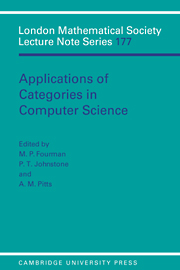 Applications of Categories in Computer Science
Applications of Categories in Computer Science Published online by Cambridge University Press: 24 September 2009
Abstract
There are many situations in logic, theoretical computer science, and category theory where two binary operations—one thought of as a (tensor) “product”, the other a “sum”—play a key role, such as in distributive categories and in -autonomous categories. (One can regard these as essentially the AND/OR of traditional logic and the TIMES/PAR of (multiplicative) linear logic, respectively.) In the latter example, however, the distributivity one often finds is conspicuously absent: in this paper we study a “linearisation” of distributivity that is present in this context. We show that this weak distributivity is precisely what is needed to model Gentzen's cut rule (in the absence of other structural rules), and show how it can be strengthened in two natural ways, one to generate full distributivity, and the other to generate -autonomous categories.
Introduction
There are many situations in logic, theoretical computer science, and category theory where two binary operations, “tensor products” (though one may be a “sum”), play a key role. The multiplicative fragment of linear logic is a particularly interesting example as it is a Gentzen style sequent calculus in which the structural rules of contraction, thinning, and (sometimes) exchange are dropped. The fact that these rules are omitted considerably simplifies the derivation of the cut elimination theorem. Furthermore, the proof theory of this fragment is interesting and known [Se89] to correspond to *-autonomous categories as introduced by Ban in [Ba79].
In the study of categories with two tensor products one usually assumes a distributivity condition, particularly in the case when one of these is either the product or sum.
To save this book to your Kindle, first ensure no-reply@cambridge.org is added to your Approved Personal Document E-mail List under your Personal Document Settings on the Manage Your Content and Devices page of your Amazon account. Then enter the ‘name’ part of your Kindle email address below. Find out more about saving to your Kindle.
Note you can select to save to either the @free.kindle.com or @kindle.com variations. ‘@free.kindle.com’ emails are free but can only be saved to your device when it is connected to wi-fi. ‘@kindle.com’ emails can be delivered even when you are not connected to wi-fi, but note that service fees apply.
Find out more about the Kindle Personal Document Service.
To save content items to your account, please confirm that you agree to abide by our usage policies. If this is the first time you use this feature, you will be asked to authorise Cambridge Core to connect with your account. Find out more about saving content to Dropbox.
To save content items to your account, please confirm that you agree to abide by our usage policies. If this is the first time you use this feature, you will be asked to authorise Cambridge Core to connect with your account. Find out more about saving content to Google Drive.